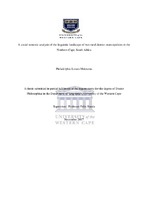| dc.contributor.advisor | Banda, Felix | |
| dc.contributor.author | Mokwena, Philadelphia Lorato | |
| dc.date.accessioned | 2018-05-29T08:23:23Z | |
| dc.date.available | 2018-05-29T08:23:23Z | |
| dc.identifier.uri | http://hdl.handle.net/11394/6050 | |
| dc.description | Philosophiae Doctor - PhD (Linguistics, Language and Communication) | |
| dc.description.abstract | Linguistic Landscape (LL) studies typically focus on public signage displayed in urban
environments, therefore LL is associated with cityscapes. There is limited research related to
the LL of non-urban environments or ruralscapes. Another limiting aspect of the
conceptualisation of LL is its emphasis on language only as a resource used in the
construction of the LL. This study explored the Northern Cape rural landscape, particularly
the Frances Baard District Municipality and John Taolo Gaestewe District Municipality. The
study analysed various semiotic resources drawn on in the creation, narration and negotiation
of the rural landscape. This study employed a multimodal ecological approach towards
theorising and analysing the rural linguistic landscape of the Northern Cape. Semiotic
remediation as repurposing was used to account for the extended sign systems in rural areas,
in which sign-making and consumption is not necessarily dependent of written or 'visible'
signs. In turn therefore, the study focused on aspects (visible and invisible signage; scripted
and unscripted sign-making and consumption) that contributed to the construction of the rural
landscape as distinct from urban landscapes. Gramsci's notion of site of struggle was drawn
on to account for how meaning and space is constantly contested, as illustrated through the
commercial signage, linguistic and naming practices of tuckshops. Material culture of
multilingualism was employed to account for how written signage is used collaboratively
with other materialities for sense-making purposes. Additionally, the adoption of material
culture of multilingualism approach allowed for the exploration of the transformative role of
a multilingual written and oral environment. More significantly is the study's contribution to
the development of a more comprehensive theoretical approach to LL, than is currently in
place. The study also contributes to the data collection tools and analytical frameworks of
multilingualism studies. | |
| dc.language.iso | en | |
| dc.publisher | University of the Western Cape | |
| dc.title | A social semiotic analysis of the linguistic landscape of two rural district municipalities in the Northern Cape, South Africa | |
| dc.rights.holder | University of the Western Cape | |

